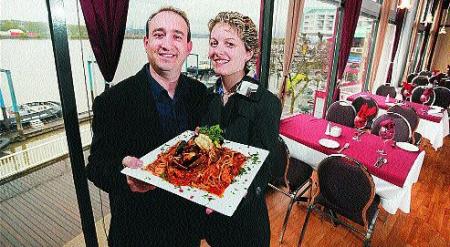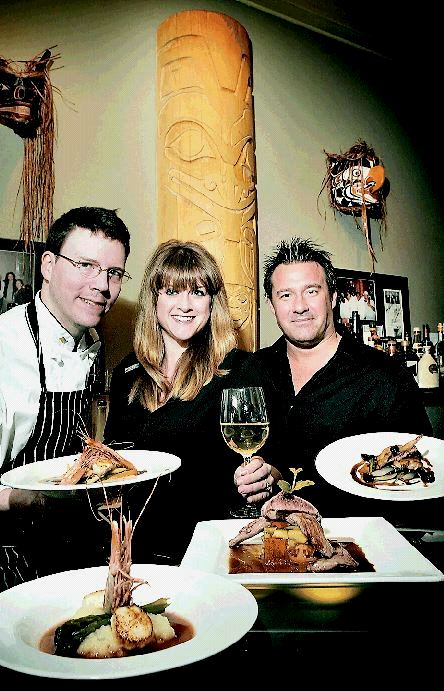Laguna Blu puts authentic Italian on the menu and patrons on the dancefloor
Alfie Lau
Sun

Daniel and Elena Morosan of Laguna Blu restaurant at Westminster Quay display their house specialty, Laguna Blu Lobster Seafood Linguini. Photograph by : Stuart Davis, Vancouver Sun
When a fire forced Daniel Morosan to move his Italian dinner and dance restaurant to the top floor of the Westminster Quay Public Market, so began the story of Laguna Blu.
Voted as the best dinner and dance restaurant in New Westminster the last two years, Laguna Blu arose from the ashes of Con Amore E Sapore (the former name of Morosan’s restaurant on Royal Avenue) and built its reputation on generous and affordable Italian dishes that wouldn’t be out of place in Morosan’s ancestral home in Naples.
On a recent weekday, we decided to see what magic Morosan and wife Elena were cooking up at Westminster Quay.
We started with two traditional appetizers, the antipasto for two ($12.95), which included ample portions of Parma prosciutto, Genoa salami, Asiago and Fontinella cheeses, artichokes, olives and mixed pickles; and the deep-fried calamari ($6.95).
The antipasto was a great mix of traditional Italian favourites. The meats were lean and fresh while the cheeses were strong without being overpowering.
I couldn’t get enough of the calamari, which was a veritable steal at $7 because the portion size was larger than some main servings of calamari I’ve had elsewhere.
By using baby squid instead of older octopi, Morosan achieves a delectable taste sensation.
For our mains, we had to go with a couple of pasta dishes, along with a meat dish.
The spaghetti with Bolognese sauce ($11.95) was the choice of my friend, who believes Italian restaurants don’t spend enough care and attention on staples like this.
Not so with Morosan, who makes his pasta daily and uses only the freshest ingredients to make the sauce.
“I’ve been in the business for 24 years and there’s no way you can have bad pasta at an Italian restaurant,” said Morosan. “I only use authentic Italian recipes and when you combine it with fresh ingredients, that’s how you get a great meal.”
Our pregnant diner’s ravioli ($14.95) was another example of homemade Italian pasta, but infused with fresh meat, it was a taste treat. Even while eating for two, she still had enough for the next day’s lunch.
I went with the red snapper ($19.95), pan fried and served in a tomato sauce and a veritable garden of vegetables, including potatoes, carrots and eggplant.
The fish was well prepared, but I found the sauce a bit too overwhelming. Fish should be able to stand on its own and I found the mix of sauce, capers and fish a bit too much for my taste buds.
An item that is no longer on the menu, but may be ordered by special request is the Mayor’s steak, a 11/2 pound steak that New Westminster Mayor Wayne Wright has been known to enjoy.
“Laguna Blu is one of my favourite restaurants in the city,” said Wright, who said he helped Morosan find the location at the Quay after the fire.
“When my friends had a surprise birthday party for me [in April], we had it at Laguna Blu and it was a great meal.”
Wright said his favourite dishes are the creamy carbonara pasta and the rack of lamb, while Morosan said his favourite is the seafood pasta.
“I love seafood and the different ways you can cook it,” Morosan said. “Add in the homemade pasta and it’s something I really enjoy.”
To finish our meal, we had the tuxedo truffle dessert ($5.50), which is a mix of white and dark chocolate cake. With three forks attacking the cake, it didn’t take long for it to disappear into our full bellies.
While we went for dinner on a quiet weekday, things really get crazy starting on Thursday night when Morosan brings in a band and diners can work off their dinners with some energetic dancing.
“Everybody loves to dance,” said Morosan. “Start with a fine meal, add in the dancing and you have a great night.”
– – –
AT A GLANCE
Laguna Blu Italian Restaurant
New Westminster Quay Public Market, 2nd floor, 810 Quayside Dr.
Phone (604) 522-4040
www.lagunablu.ca
Hours: Mon. – Wed., 11 a.m. to 3 p.m., 5 to 9 p.m.
Thurs., 11 a.m. to 3 p.m., 5 to 11 p.m.
Fri. to Sun., 11 a.m. to 1 a.m.
© The Vancouver Sun 2008





